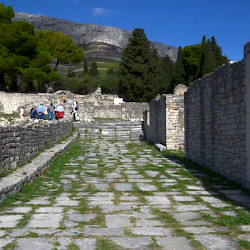Narthex
Narthex (Greek νάρθηξ): vestibule (or corridor) in front of the entrance to a Byzantine church.

The first Christians gathered at their own houses, but there were already churches in the third century. After the emperors Licinius and Constantine had allowed Christianity (the "Edict of Milan", 312), there were more churches. The first imperial basilicas were built in the 320s: in Rome there was the Lateran and the two basilicas dedicated to Saint Peter and Saint Paul; in Constantinople the Church of Divine Peace, in Jerusalem the basilica of the Holy Sepulcher and in Bethlehem the church of the Nativity.
In this age, Christianity started to change. Those Christians who believed that the worship of Christ excluded the worship of other gods became more important and the ritual of baptism became the sign that one belonged to the real, official Christian church as defined during the Council of Nicaea (325). The proper teaching of faith became increasingly important and more then ever, there were two groups of people: those who had already been baptized and tho catechumens, i.e., those who were still being prepared for baptism.
In the church itself, only those people were welcome who had been baptized. Other visitors (the catechumens but also penitents), were supposed not to enter this sacred space, but could wait in the narthex, which is essentially a small hall in front of the church itself. In Armenia, similar vestibules exists, which are called gavit.
 Constantinople, Hagia Sophia, Narthex |
 Resafa, Cathedral, Narthex |
 Faqra, Byzantine Church, Narthex |
 Salona, Episcopal Complex, Basilica, Narthex |